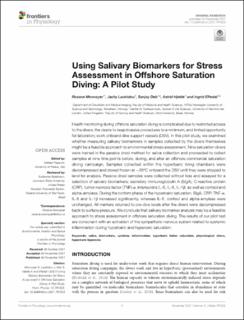| dc.description.abstract | Health monitoring during offshore saturation diving is complicated due to restricted access to the divers, the desire to keep invasive procedures to a minimum, and limited opportunity for laboratory work onboard dive support vessels (DSV). In this pilot study, we examined whether measuring salivary biomarkrers in samples collected by the divers themselves might be a feasible approach to environmental stress assessment. Nine saturation divers were trained in the passive drool method for saliva collection and proceeded to collect samples at nine time points before, during, and after an offshore commercial saturation diving campaign. Samples collected within the hyperbaric living chambers were decompressed and stored frozen at −20°C onboard the DSV until they were shipped to land for analysis. Passive drool samples were collected without loss and assayed for a selection of salivary biomarkers: secretory immunoglobulin A (SIgA), C-reactive protein (CRP), tumor necrosis factor (TNF)-α, interleukins IL-6, IL-8, IL-1β, as well as cortisol and alpha-amylase. During the bottom phase of the hyperbaric saturation, SIgA, CRP, TNF-α, IL-8 and IL-1β increased significantly, whereas IL-6, cortisol and alpha-amylase were unchanged. All markers returned to pre-dive levels after the divers were decompressed back to surface pressure. We conclude that salivary biomarker analysis may be a feasible approach to stress assessment in offshore saturation diving. The results of our pilot test are consonant with an activation of the sympathetic nervous system related to systemic inflammation during hyperbaric and hyperoxic saturation. | en_US |

